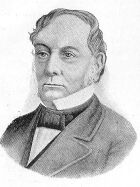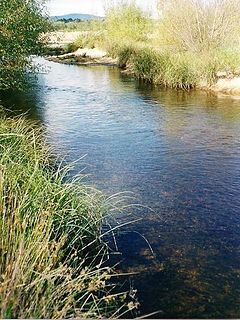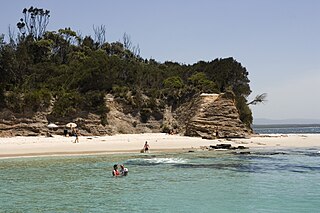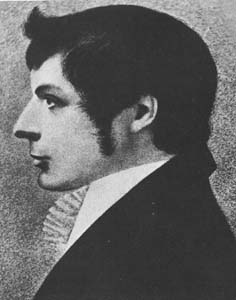| James Meehan | |
|---|---|
| Born | 1774 Ireland |
| Died | 21 April 1826 Macquarie Field, New South Wales, Australia |
| Occupation | Surveying |
| Years active | 1800 - 1822 |
| Known for | Early Australian surveyor |
James Meehan [1] [2] (1774 – 21 April 1826) was an Irish-Australian explorer and surveyor.

Ireland is an island in the North Atlantic. It is separated from Great Britain to its east by the North Channel, the Irish Sea, and St George's Channel. Ireland is the second-largest island of the British Isles, the third-largest in Europe, and the twentieth-largest on Earth.

Australia, officially the Commonwealth of Australia, is a sovereign country comprising the mainland of the Australian continent, the island of Tasmania and numerous smaller islands. It is the largest country in Oceania and the world's sixth-largest country by total area. The neighbouring countries are Papua New Guinea, Indonesia and East Timor to the north; the Solomon Islands and Vanuatu to the north-east; and New Zealand to the south-east. The population of 25 million is highly urbanised and heavily concentrated on the eastern seaboard. Australia's capital is Canberra, and its largest city is Sydney. The country's other major metropolitan areas are Melbourne, Brisbane, Perth and Adelaide.

Surveying or land surveying is the technique, profession, and science of determining the terrestrial or three-dimensional positions of points and the distances and angles between them. A land surveying professional is called a land surveyor. These points are usually on the surface of the Earth, and they are often used to establish maps and boundaries for ownership, locations, such as building corners or the surface location of subsurface features, or other purposes required by government or civil law, such as property sales.
Contents
Meehan was born in Ireland in 1774, and was one of a number of political prisoners who arrived in Australia in February 1800. Two months later he became an assistant to Charles Grimes, the surveyor-general, and went with him to explore the Hunter River in 1801. He was also with Grimes on the expedition to explore King Island and Port Phillip in the summer of 1802-3. Grimes had leave of absence from August 1803 to go to England, and during his absence for about three years, Meehan did much of his work with the title of assistant-surveyor. In October 1805 Governor King directed him to trace the course of the Nepean to the southward a little beyond Mount Taurus, and in October 1807 Meehan prepared his plan of Sydney.
Charles Grimes was an English surveyor who did some valuable work in colonial Australia. He served as Surveyor General of New South Wales and discovered the Yarra River in what is now the state of Victoria. He is perhaps best known for being the surveyor who mapped the route of the Hobart Road, Tasmania's main north-south arterial route. Much of the modern Midland Highway still follows the route that he planned.

The Hunter River is a major river in New South Wales, Australia. The Hunter River rises in the Liverpool Range and flows generally south and then east, reaching the Tasman Sea at Newcastle, the second largest city in New South Wales and a major harbour port. Its lower reaches form an open and trained mature wave dominated barrier estuary.

King Island is an island in the Bass Strait, belonging to the Australian state of Tasmania. It is the largest of three islands known as the New Year Group, and the second-largest island in Bass Strait. The island's population at the 2016 census was 1,585 people, up from 1,566 in 2011. The local government area of the island is the King Island Council.
In 1812 Governor Macquarie sent him to Tasmania with instructions to remeasure the whole of the farms granted by former governors and himself. He accompanied Hamilton Hume in some explorations in southern New South Wales in 1816, when Lake George was discovered, and in 1818 Meehan was appointed deputy surveyor-general. It was around this time that he named the settlement of Goulburn after Henry Goulburn, the Under-Secretary for War and the Colonies.

Major General Lachlan Macquarie, CB was a British Army officer and colonial administrator from Scotland. Macquarie served as the fifth and last autocratic Governor of New South Wales from 1810 to 1821, and had a leading role in the social, economic and architectural development of the colony. He is considered by historians to have had a crucial influence on the transition of New South Wales from a penal colony to a free settlement and therefore to have played a major role in the shaping of Australian society in the early nineteenth century. In 1816 Macquarie gave orders that led to the Appin Massacre of Gundungurra and Dharawal people.

Tasmania is an island state of Australia. It is located 240 km (150 mi) to the south of the Australian mainland, separated by Bass Strait. The state encompasses the main island of Tasmania, the 26th-largest island in the world, and the surrounding 334 islands. The state has a population of around 526,700 as of March 2018. Just over forty percent of the population resides in the Greater Hobart precinct, which forms the metropolitan area of the state capital and largest city, Hobart.

Hamilton Hume was an early explorer of the present-day Australian states of New South Wales and Victoria. In 1824, along with William Hovell, Hume participated in an expedition that first took an overland route from Sydney to Port Phillip. Along with Sturt in 1828, he was part of an expedition of the first Europeans to discover the Darling River.
He endeavoured in this year without success to find a practicable road over the Shoalhaven River so that communication might be opened up with Jervis Bay, but continuing his efforts early in 1820 he went through some very difficult country after crossing the river from the east, and then connecting with his 1818 track.

The Shoalhaven River is a perennial river that rises from the Southern Tablelands and flows into an open mature wave dominated barrier estuary near Nowra on the South Coast of New South Wales, Australia.

Jervis Bay is a 102-square-kilometre (39 sq mi) oceanic bay and village on the south coast of New South Wales, Australia, said to possess the whitest sand in the world.
In 1822 he resigned his position and was granted a pension of £100 a year in 1823. He died on 21 April 1826. He was a most capable and industrious official, and though he does not rank among the leading explorers, he did some very valuable work while carrying out his duties during the first 20 years of the nineteenth century.















